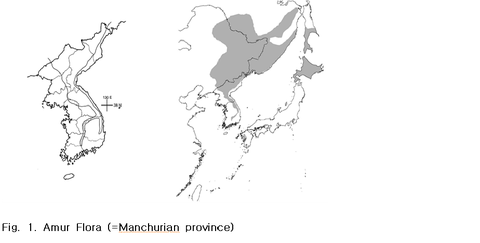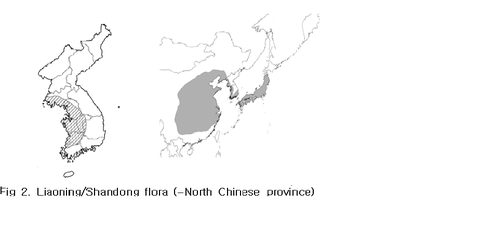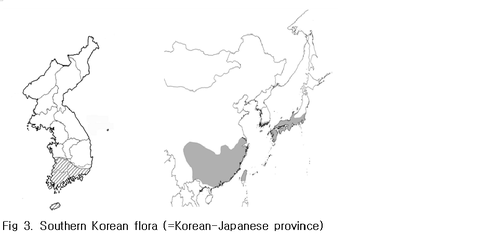The flora of Korea is poorly known well due to its geographic position between China and Japan, although it has a diversity of terrestrial formations and wide ranges in altitude (0-2,000m above sea level), precipitation levels (6,00-1,800 mm) and average yearly temperature (-2.5-25C). These variations in temperature and rainfall within relatively small areas result in three different temperate forest zones (cold, cool, and warm). Forest in Korea covers 12,930,000ha or 58 percent of the area of the country, with broad leaf and conifer forest. Seventy percent of the land surface is steep and mountainous.
A range of forest types are found, including evergreen and warm temperate forest on the southern coast, cool and cold temperate forest in the east, montane conifer forest and cold temperate forest in the north, and mixed forest (conifer and broad leaf) in the west. Korea has more than 3,000 higher plant species, including 650 woody species in 1,000 genera and 200 families. There are 28 species of conifer and more than 500 species of broad leaf trees , with a high level of endemism.
Although a floristic province is a geographic area with a relatively uniform composition of plant species, adjacent floristic provinces do not usually have a sharp boundary. A transitional area, which is usually called vegetation tension zone, in which many species from both regions overlap can be found in west side of Korean peninsula. In addition, Ulleung and Jeju Islands are characterized by an exceptionally large number of endemic species, but these taxa belong to synonyms of the related species. These islands contain a subsets of the Korean peninsula flora, rather than a unique flora.
The flora of the Eastern Asiatic region is characterized by a large number of endemic general. The major subdivision of the Eastern flora composed of 13 provinces. The determination of extent of provinces is based upon diversity of endemic genera, phylogenetic divergence, and geographic origin including geologic, climatic, and geographic factors. Among 13 provinces of the Eastern Asiatic Region (Takhtajan, 1986), three different provinces such as Manchurian, Korean-Japanese, and North Chinese provinces can be recognized in Korean peninsula now. The separation of the Korean-Japanese and North Chinese provinces is newly proposed here, with the former including Manchurian province. This province includes only eastern China east of a line that passes from northwest to southwest Korea.
The distribution patterns are variously associated into diversified ecosystems from Northeast China (Fig. 1, mixed deciduous forest with Pinus koraiensis as one of the dominants). Mixed deciduous forests marked by Pinus koraiensis cover vast mountainous regions and contain a number of old floristic elements, and endemic genera are very scarce and no endemic families occur within this province. The representative species are as follows; Schisandra chinensis (Turcz.) Baillon, Ulmus laciniata (Trautv.) Mayr, Juglans mandshurica Maxim., Quercus mongolica Fisch. ex Ledeb., Tilia mandshurica Rupr. et Maxim., Phellodendron amurense Rupr., Eleutherococcus sessiliflorus (Rupr. et Maxim.) S. Y. Hu, Vitis amurensis Rupr., Picea jezoensis (Siebold et Zucc.) Carrière, Platycladus orientalis (L.) Franco, Abies holophylla Maxim., Betula costata Trautv., Salix kangensis Nakai, Rhododendron schlippenbachii Maxim., Pyrus ussuriensis Maxim., Acer mandshuricum Maxim., Acer komarovii Pojarkova, Acer barbinerve Maxim., Acer caudatum var. ukurunduense (Trutv. et C. A. Mey.) Rehder, Acer pictum var. mono (Maxim.) Maxim. ex Franch., Acer tataricum subsp. ginnala (Maxim) Wesm., Deutzia glabrata Kom.,Oplopanax elatus (Nakai) Nakai,Syringa wolfii C. K. Schneid., Syringa reticulata (Blume) H. Hara, Abies nephrolepis (Trautv.) Maxim., Betula davurica Pall., and Euonymus verrucosus Scop. var. pauciflorus (Maxim.) Regel
The characteristic vegetation of North China is a drier mixed deciduous oak forest marked by Pinus tabulaeformis or P. densiflora (Fig. 2, from maritime areas to the Liaotung and Shandong peninsulas). North China has a rather ancient flora that dates from the Tertiary. These species are examples of North China province; Philadelphus pekinensis Rupr., Rhus chinensis Mill., Celtis sinensis Persoon, Clerodendrum trichotomum Thunb., Euonymus hamiltonianus Wall., Grewia biloba G. Don, Cocculus orbiculatus (L.) DC,. Akebia quinata (Houtt.) Decne., Rhodotypos scandens (Thunb.) Makino, Betula chinensis Maxim,. Platycarya strobilacea Siebold et Zucc., and Hovenia dulcis Thunb.
In addition, it is reasonable to keep the original the Japan-Korean Province as separable and distinct in a floristic sense. It may also imply that the degree of diversification is more pronounced and more progressive in this province. Many evergreen species, which belong to Lauraceae, Fagaceae, Hamamelidaceae, and Aquifoliaceae. Tsuga diversifolia (Maxim.) Mast., Pinus parviflora Siebold et Zucc., Pinus densiflora Siebold et Zucc., Celtis sinensis Persoon, Larix gmelinii (Rupr.) Kuzen., Pinus thunbergii Parl.,Chamaecyparis obtusa (Siebold et Zucc.) Endl.,Magnolia kobus A. DC.,Carpinus tschonoskii (Siebold et Zucc.) Maxim.,Stewartia pseudocamellia Maxim., Rhododendron tschonoskii Maxim., and Acer palmatum Thunb. are examples of deciduous woody plants.
The region supports some 3,381 species of vascular plants of which approximately 2.0% are thought to be endemic. The Baekdu mountains of Korean peninsula are a recognized global biodiversity hotspot, supporting over 45% species.



